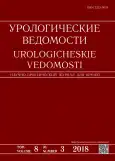Functional and early oncological results in 2D vs 3D laparoscopic prostatectomy
- Authors: Bogomolov O.A.1, Shkolnik M.I.1, Belov A.D.1, Sidorova S.A.1, Prokhorov D.G.1, Lisitsyn I.Y.1, Emirgaev Z.K.1
-
Affiliations:
- Russian Research Center of Radiology and Surgical Technologies named after Academician A.M. Granov, Ministry of Healthcare of the Russian Federation
- Issue: Vol 8, No 3 (2018)
- Pages: 5-10
- Section: Articles
- URL: https://journals.rcsi.science/uroved/article/view/10457
- DOI: https://doi.org/10.17816/uroved835-10
- ID: 10457
Cite item
Abstract
Aim. To evaluate functional and early oncologic results with 2D and 3D laparoscopic prostatectomy in patients with localized prostate cancer.
Materials and methods. In 2016 to 2017, 124 laparoscopic radical prostatectomies were performed for localized prostate cancer, 71 using 2D-HD and 53 using 3D-HD laparoscopic systems (Karl Storz). Data on total operative time, time required for prostatectomy and for anastomosis, estimated blood loss, intraoperative and early postoperative complications (Clavien-Dindo grade), early functional results, surgical margins, upgrading of clinical stage, and frequency of biochemical recurrence were recorded.
Results. The total operative was significantly higher in the 2D than in the 3D group (152 min [range 100–192 min] vs 126 min [90–154 min]), (p < 0.05). The shorter time in the 3D group was achieved by a decrease in the anastomosis time (38 ± 4 min vs 26 ± 4 min, p < 0.05). Significant blood loss was significantly greater in the 2D group (240 ± 80 ml vs 190 ± 70 ml, p < 0.05). The two groups did not differ significantly in terms of the incidence and severity of postoperative complications.
Conclusion. Compared with traditional 2D devices, using stereoscopic 3D laparoscopic devices for prostatectomy reduces total operative time, particularly during the reconstructive stage, as well as the volume of intraoperative blood loss. Additional prospective, randomized trials and longer postoperative follow-up are needed to confirm these findings.
Full Text
##article.viewOnOriginalSite##About the authors
Oleg A. Bogomolov
Russian Research Center of Radiology and Surgical Technologies named after Academician A.M. Granov, Ministry of Healthcare of the Russian Federation
Author for correspondence.
Email: urologbogomolov@gmail.com
Candidate of Medical Sciences, Research Fellow, Department of Operative Oncology and Operative Urology
Russian Federation, Saint PetersburgMikhail I. Shkolnik
Russian Research Center of Radiology and Surgical Technologies named after Academician A.M. Granov, Ministry of Healthcare of the Russian Federation
Email: shkolnik_phd@mail.ru
Doctor of Medical Sciences, Sсientific Head, Department of Operative Oncology and Operative Urology
Russian Federation, Saint PetersburgAndrej D. Belov
Russian Research Center of Radiology and Surgical Technologies named after Academician A.M. Granov, Ministry of Healthcare of the Russian Federation
Email: info@rrcrst.ru
Candidate of Medical Sciences, Head, Department of Operative Oncology and Operative Urology
Russian Federation, Saint PetersburgSvetlana A. Sidorova
Russian Research Center of Radiology and Surgical Technologies named after Academician A.M. Granov, Ministry of Healthcare of the Russian Federation
Email: info@rrcrst.ru
Candidate of Medical Sciences, Urologist, Department of Operative Oncology and Operative Urology
Russian Federation, Saint PetersburgDenis G. Prokhorov
Russian Research Center of Radiology and Surgical Technologies named after Academician A.M. Granov, Ministry of Healthcare of the Russian Federation
Email: info@rrcrst.ru
Candidate of Medical Sciences, Senior Research Fellow, Department of Operative Oncology and Operative Urology
Russian Federation, Saint PetersburgIgor Yu. Lisitsyn
Russian Research Center of Radiology and Surgical Technologies named after Academician A.M. Granov, Ministry of Healthcare of the Russian Federation
Email: urologlis@mail.ru
Candidate of Medical Sciences, Research Fellow, Department of Operative Oncology and Operative Urology
Russian Federation, Saint PetersburgZaur K. Emirgaev
Russian Research Center of Radiology and Surgical Technologies named after Academician A.M. Granov, Ministry of Healthcare of the Russian Federation
Email: info@rrcrst.ru
Clinical Resident, Research Fellow, Department of Operative Oncology and Operative Urology
Russian Federation, Saint PetersburgReferences
- EAU Guidelines. Edn. presented at the EAU Annual Congress Copenhagen 2018. ISBN 978-94-92671-01-1.
- Hakimi AA, Feder M, Ghavamian R. Minimally invasive approaches to prostate cancer: a review of the current literature. Urol J. 2007;4(1):130-137.
- Patel VR, Sivaraman A, Coelho RF, et al. Pentafecta: a new concept for reporting outcomes of robot-assisted laparoscopic radical prostatectomy. Eur Urol. 2011;59(5):702-707. doi: 10.1016/j.eururo.2011.01.032.
- Dindo D, Demartines N, Clavien P. Classification of surgical complications. Ann Surg. 2004;240:205-213. doi: 10.1007/978-1-4471-4354-3_3.
- Schroeck FR, Krupski TL, Sun L, et al. Satisfaction and regret after open retropubic or robot-assisted laparoscopic radical prostatectomy. Eur Urol. 2008;54(4):785-793. doi: 10.1016/j.eururo.2008.06.063.
- Robertson C, Close A, Fraser C, et al. Relative effectiveness of robot-assisted and standard laparoscopic prostatectomy as alternatives to open radical prostatectomy for treatment of localised prostate cancer: a systematic review and mixed treatment comparison meta-analysis. BJU Int. 2013;112(6):798-812. doi: 10.1111/bju.12247.
- Abdelshehid CS, Eichel L, Lee D, et al. Current trends in urologic laparoscopic surgery. J Endourol. 2005;19(1):15-20. doi: 10.1089/end.2005.19.15.
- Patel HRH, Ribal MJ, Arya M, et al. Is it worth revisiting laparoscopic three-dimensional visualization? A validated assessment. Urology. 2007;70(1):47-9. doi: 10.1016/j.urology.2007.03.014.
- Peitgen K, Walz MV, Holtmann G, Eigler FW. A prospective randomized experimental evaluation of three-dimensional imaging in laparoscopy. Gastrointest Endosc. 1996;44(3):262-7. doi: 10.1016/s0016-5107(96)70162-1.
- Chan ACW, Chung SCS, Yim APC, et al. Comparison of two-dimensional vs three-dimensional camera systems in laparoscopic surgery. Surg Endosc. 1997;11(5):438-40. doi: 10.1007/s004649900385.
- Wenzl R, Lehner R, Vry U, et al. Three-dimensional video endoscopy: clinical use in gynaecological laparoscopy. Lancet. 1994;344(8937):1621-1622. doi: 10.1016/s0140-6736(94) 90412-x.
- Hanna GB, Cuschieri A. Influence of two-dimensional and three-dimensional imaging on endoscopic bowel suturing. World J Surg. 2000;24(4):444-448. doi: 10.1007/s002689910070.
- Taffinder N, Smith SGT, Huber J, et al. The effect of a second-generation 3D endoscope on the laparoscopic precision of novices and experienced surgeons. Surg Endosc. 1999;13(11):1087-1092. doi: 10.1007/s004649901179.
Supplementary files







